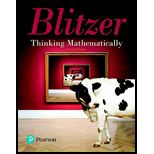
The 12 preference ballots for four candidates (A, B, C, and D) are shown. Construct a preference table to illustrate the results of the election.
ABCD BDCA CBDA ABCD CBDA ABCD
BDCA BDCA CBAD CBAD ABCD CBDA
A preference table to show the results of the election from the data given below –
The
ABCD, BDCA, CBDA, ABCD, CBDA, ABCD, BDCA, BDCA, CBAD, CBAD, ABCD, CBDA
Answer to Problem 1RE
Solution:
The preference table is shown below:
| Number of candidates voted | ||||
| First choice | A | C | B | C |
| Second choice | B | B | D | B |
| Third choice | C | D | C | A |
| Fourth choice | D | A | A | D |
Explanation of Solution
Given:
The
ABCD, BDCA, CBDA, ABCD, CBDA, ABCD, BDCA, BDCA, CBAD, CBAD, ABCD, CBDA
Construct the table for the given poll.
First, write the same order preferences once as shown below:
ABCD occurs four times.
CBDA occurs three times.
BDCA occurs three times.
CBAD occurs two times.
Now, construct a preference table with five columns and five rows:
| Number of candidates voted | ||||
| First choice | A | C | B | C |
| Second choice | B | B | D | B |
| Third choice | C | D | C | A |
| Fourth choice | D | A | A | D |
Want to see more full solutions like this?
Chapter 13 Solutions
Thinking Mathematically (7th Edition)
- Can you solve this two numerical method eqn and teach me.arrow_forwardFind the area between the following curves. x=-4, x=2, y=ex, and y = 3 - ex Set up the integral (or integrals) needed to compute this area. Use the small (Type exact answers in terms of e.) 3 In 2 A. S √ [3-2e*] dx+ -4 2 S [2ex-3] dx 3 In 2 B. dx Find the area between the curves. Area = (Type an exact answer in terms of e.)arrow_forwardUse the definite integral to find the area between the x-axis and f(x) over the indicated interval. Check first to see if the graph crosses the x-axis in the given interval. f(x)=8-2x²: [0,4] Set up the integral (or integrals) needed to compute this area. Use the smallest possible number of integrals. Select the correct choice below and fill in the answer boxes to ○ A. dx B. 2 S 8-2x² dx+ 4 S 2 8-2x2 dx C. dx + S dx For the interval [0,4], the area between the x-axis and f(x) is (Type an integer or a simplified fraction.)arrow_forward
- Pollution from a factory is entering a lake. The rate of concentration of the pollutant at time t is 5 given by P'(t) = 126t², where t is the number of years since the factory started introducing pollutants into the lake. Ecologists estimate that the lake can accept a total level of pollution of 600 units before all the fish life in the lake ends. Can the factory operate for 2 years without killing all the fish in the lake? Set up the integral that would determine the pollution level after 2 years. 2 5 126t 2 dt Can the factory operate for 2 years without killing all the fish in the lake? Thee factory can operate for 2 years without killing all the fish in the lake because the value of the integral is , which is less than 600. (Round to the nearest integer as needed.)arrow_forwardUse the definite integral to find the area between the x-axis and f(x) over the indicated interval. Check first to see if the graph crosses the x-axis in the given interval. f(x)=4x-12; [2,6] The area between the x-axis and f(x) is (Type an integer or a simplified fraction.)arrow_forwardEvaluate the definite integral. 70 √5√2-6 3 dz 70 S 5√2-6 dz= 7 江 (Type an integer or decimal rounded to two decimal places as needed.)arrow_forward
- Find the area between the following curves. 2 y=x³-x²+x+4; y=5x² -7x+4 The area between the curves is (Simplify your answer.) ...arrow_forwardFind the area of the shaded region. 3- -1 -3- Q The total area of the shaded regions is (Simplify your answer.) y=9-x² Q 1 3 5 Xarrow_forwardFind the area of the region bounded by the graphs of the given equations. y=17x, y=x² ... The area is (Type an integer or a simplified fraction.)arrow_forward
- Find the area between the curves. y=x-26, y=9-2x ... The area between the curves is (Type an integer or decimal rounded to the nearest tenth as needed.)arrow_forwardYou are constructing a box out of cardboard with the dimensions 5 m by 6 m. You then cut equal-size squares from each corner so you may fold the edges. Let x be the side length of each square. Find that maximizes the volume of the box. Answer exactly. 8 x x H x ४ x ४ ४ marrow_forwardFind the lengths of PR and OR in terms of the angles α and β. Find the angles ∠ONQ and ∠NPQ. Find the lengths of ON and PN in terms of the angle β. Find the length of PQ. Find the length of QR. Find the length of OM. Find the length of RM. What formula can you write down by noting that PR = QR + PQ? What formula can you write down by noting that OR = OM - RM?arrow_forward
 Algebra & Trigonometry with Analytic GeometryAlgebraISBN:9781133382119Author:SwokowskiPublisher:Cengage
Algebra & Trigonometry with Analytic GeometryAlgebraISBN:9781133382119Author:SwokowskiPublisher:Cengage

